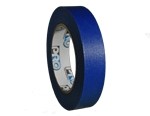The Call It “Painting” But They Should Call It “Taping”
 Professionals who do quality painting, whether in a house, on a car, or in the studio, know that the quality of the prep work is the most important part of getting great results.
Professionals who do quality painting, whether in a house, on a car, or in the studio, know that the quality of the prep work is the most important part of getting great results.
Actually applying paint usually goes really fast, but if the prep work preceding it is not done properly, your final product is a waste of time and money.
The most important part of prep work is stripping, sanding and masking.
Let’s talk about the masking.
Blue (or green) masking tape is known as painters tape, and is well worth the extra cost, since it sticks better and comes up clean, even if left in place for several days.
Here are some tips for using masking tape.
Make sure the surface is clean. Tape will not adhere to dusty, oily or wet surfaces.
Test the tape’s stickiness on an unobtrusive part of the surface being masked to insure that no damage will be done when the tape is removed.
Press down the edges of the tape, once applied, to insure that tape can’t seep under the tape.
Don’t stretch the tape. If it is stretched when applied, it will creep back to its original shape, leaving part of your surface unmasked.
If you are taping an uneven surface, lay the tape gently over the uneven portions rather than forcing it, so it doesn’t contract and let paint bleed through.
Leave masking tape in place for at least a couple of hours after the paint seems dry so that there will be a hard paint edge where it meets the masking.
Allabouttape.com is your source for information about the adhesive tape industry. All the news about gaffers tape, safety tapes, duct tape, vinyl tapes and new developments in tape technology. Share your comments and questions with us.
